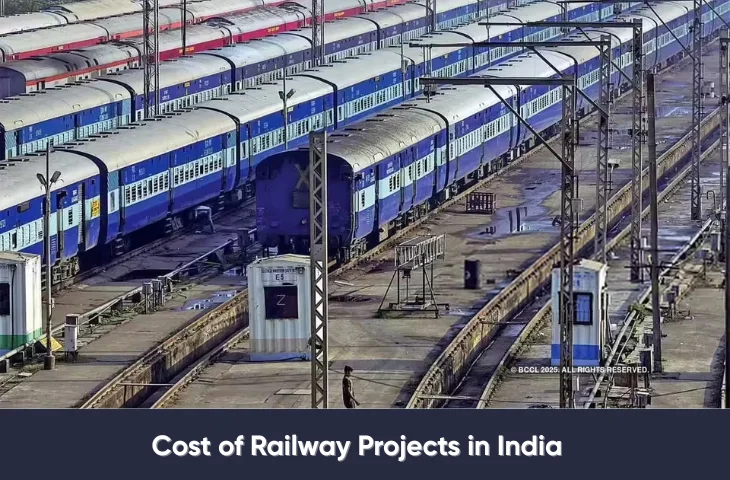Last updated on September 25th, 2025 at 04:49 pm
Cost of Railway Projects: Understanding the cost of railway projects and subsidies reveals how governments and transport authorities balance infrastructure expenditure with public affordability. Whether launching ultra-modern high-speed lines or upgrading regional tracks, planning, funding, and subsidy flows shape the success and sustainability of railways.
Cost of Major Railway Projects in India
Rail infrastructure projects come with staggering price tags, often running into billions of dollars or crores of rupees. Given below are some real-world examples:
- Moscow–St. Petersburg High-Speed Railway (Russia)
- Estimated at over 2.3 trillion roubles (US $26 billion)
- State will provide loans (300 billion roubles) and subsidies (328 billion roubles from 2024–38)
- Mumbai–Ahmedabad High-Speed Rail Corridor (India)
- Total cost includes trains, interest during construction, and duties. Japanese funding covers 81%, with the rest borne by Maharashtra and Gujarat.
- The project suffered a ~48% cost escalation due to COVID-19 and land acquisition delays.
- Bhanupli–Leh Line (India)
- Estimated at ₹99,000 crore (~US $12.4 billion), including ₹62,000 crore for tunneling, bridges, and extreme-terrain engineering.
- Kashmir Rail Link (Udhampur–Baramulla)
- A 272-km connection featuring 36 tunnels and 943 bridges, built at a cost of US $5 billion.
- Itarsi–Nagpur 4th Line (India)
- Part of a multi-tracking package totalling ₹11,169 crore; this segment costs ₹5,451 crore and boosts freight capacity while reducing CO₂ emissions.
- Ratlam–Nagda Multi-Track (India)
- ₹1,018 crore project to add 3rd and 4th lines over 41 km; part of PM Gati-Shakti initiative to enhance connectivity and lower logistics cost.
| Project | Cost | Russia’s high-speed corridor |
| Moscow–St. Petersburg HSR | US$ 26 billion | Russia high-speed corridor |
| Mumbai–Ahmedabad HSR | Escalated cost (original +) | India, via JICA funding |
| Bhanupli–Leh Rail Line | ₹99,000 crore (~US$ 12.4 bn) | Himalayan region, India |
| Udhampur–Baramulla (Kashmir link) | US 5 billion | India, strategic connectivity |
| Itarsi–Nagpur 4th Line | ₹5,451 crore | India, freight/pax enhancement |
| Ratlam–Nagda 3rd/4th Lines | ₹1,018 crore | India, regional capacity boost |
Cost-Sharing and Government Allocations
Railway projects often rely on a mix of central, state, and international funding, along with loans and subsidies. Some of the details are given below:
| Category | Details | Amount (₹ Crore) | Additional Notes |
| Multi-Track Approvals | Two projects: 256 km doubling and a new line via Amaravati. | 6,798 | Expected completion within five years. |
| State-Level Budgets (Karnataka) | Allocation for 2024–25 Union Budget, covering rail infra, station upgrades, and electrification. | 7,559 | Key projects include Yesvantpur (₹367 crore) and Bengaluru Cantonment (₹484 crore) redevelopment. |
| Cost-Sharing Projects | Projects in partnership with state governments. | 60,000+ | Ongoing and historic collaborations between Indian Railways and states. |
Subsidies that Bridge Cost and Affordability
Subsidies are essential to keep rail travel accessible, especially in densely populated and developing nations. Given below are some subsidies that bridge the cost and affordability:
- Indian Railways Passenger Subsidy
- In FY 2023–24, approximately ₹60,466 crore was spent on subsidies—about 45% of the cost of passenger travel.
- Fare Discrepancies
- Actual cost per kilometre is estimated at ₹1.16, while IR charges just ₹0.48, indicating substantial subsidization.
These subsidies demonstrate how railways balance financial viability with affordability and social equity.
Cost Overruns & Infrastructure Risks
Delay and underestimation are recurring challenges. Recent examples of cost overruns are given below:
- Escalation Example
- Mumbai–Ahmedabad corridor saw ~48% cost increase due to external pressures
- Global Patterns
- Academic studies show urban rail capital cost variability—from US$50–150 million/km—based on underground vs. surface routes, land conditions, and urban density.
- Geographical factors influence cost overruns; Dutch projects see lower escalation (11%) versus ~44% globally
- A broader study warns of systematic underestimation in public infrastructure planning.
Why Understanding the Cost of Railway Projects and Subsidies Matters?
It is important to understand the cost of railway projects and subsidies for effective financial planning, public accessibility, strategic investment, and more. The details are given below:
- Financial Planning:
Governments must balance massive capital expenditure with operational subsidies—a complex fiscal equation. - Public Accessibility:
Subsidized fares encourage mobility equity, enabling railways to serve both rural and low-income populations. - Strategic Investment:
Railway lines such as the Kashmir link (US$5 bn) demonstrate how infrastructure can strengthen national integration and security. - Risk Management:
Awareness of cost escalation and delays leads to better project appraisal and realistic budgeting.
The cost of railway projects and subsidies encompasses a spectrum of economic, social, and strategic dimensions. Projects costing billions like HSR corridors or Himalayan lines often depend on layered funding from governments, international lenders, and subsidies. Even then, per-passenger fares remain below actual service costs.
FAQs
The estimated cost is over 2.3 trillion roubles (US $26 billion).
The estimated cost is ₹99,000 crore (US $12.4 billion), including ₹62,000 crore for tunneling, bridges, and extreme-terrain engineering.
Subsidies are not just budgetary allocations; they reflect a commitment to public welfare. When paired with cautious cost estimation and transparency, they guide railways toward sustainable, equitable development.
It is important to understand the cost of railway projects and subsidies for effective financial planning, public accessibility, strategic investment, and more.
Part of a multi-tracking package totalling ₹11,169 crore, this segment costs ₹5,451 crore and boosts freight capacity while reducing CO₂ emissions.

Hello! This is Arijit Dutta. I am a skilled Content Writer at Oliveboard with nearly 3+ years of experience in crafting engaging, informative, and exam-focused content for the Railways Domain. With a strong command of language and a keen understanding of learner needs, I contribute significantly to Oliveboard’s mission of delivering high-quality educational resources. Passionate about clear communication and continuous learning, I consistently create content that helps government job aspirants achieve their goals. Outside of work, I enjoy playing cricket and listening to music, which helps me stay balanced and creative in my professional journey.
